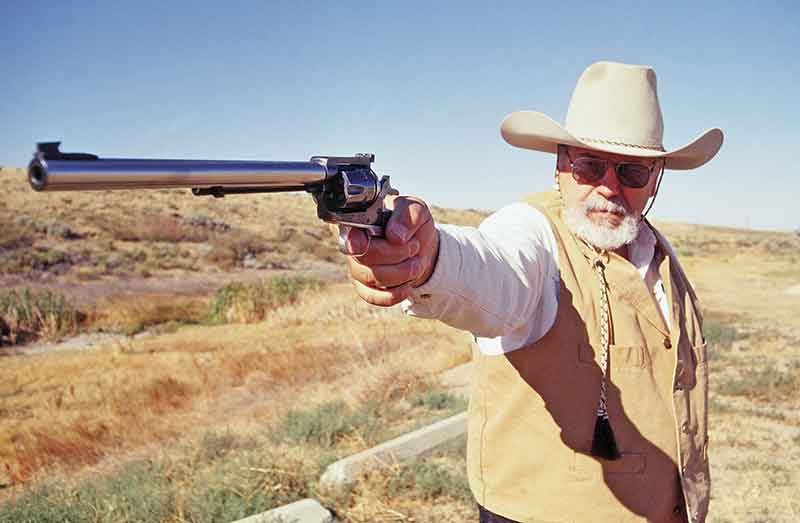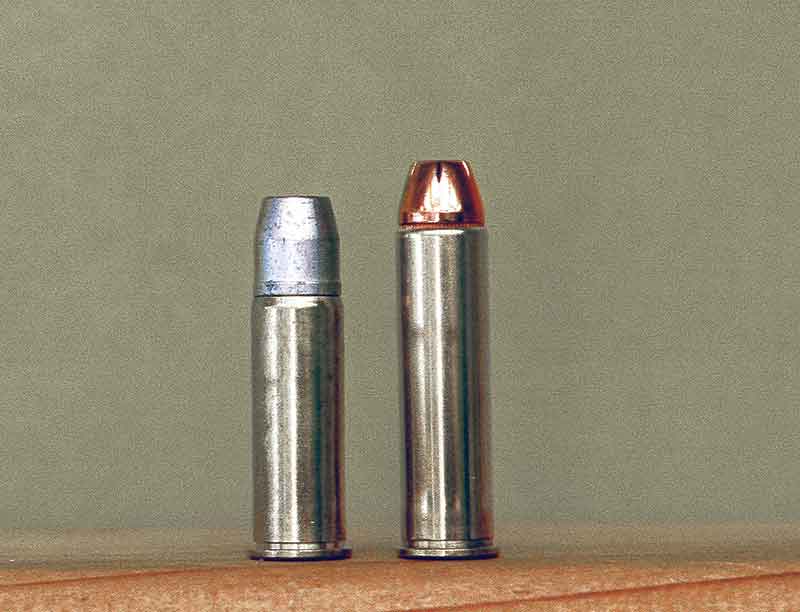Long Range Rugers
$150 Was A Lot Of Money …
It had been a long hot summer, in fact the last of three painful summers. Summers are meant for shooting, camping, hiking, outdoor activities with the family. However, my last three had been spent sitting in a graduate school classroom at the University of Montana working on my Master’s Degree. Now it was finally over. I had survived and received my degree. I deserved a reward. A stop at the Gunhaus revealed the appropriate specimen so my wife graciously presented with me with my first Long Range Ruger.
At the time, 1971, I felt $150 was a lot of money to spend for a single action Ruger sixgun, however it was unlike any Ruger .44 Magnum I had ever seen, and the stocks, although factory, were made of beautifully grained fancy walnut. What made this Ruger .44 Flat-Top different is the fact it was one of the very rare 10″ sixguns made in the early 1960s. My wife insisted we could afford it and she has proven to be far more perceptive than I am, as that Flat-Top Ruger is now worth at least six times what we paid for it even though it still remains in the Not-For-Sale category.
For hunting, that Ruger was matched up with one of the Al Goerg shoulder holsters of the time. I would hate to have to retrace all the miles the Ruger, shoulder holster, and I made together. When Ruger dropped the Flat-Top Model in favor of the Old Models in 1963, the longest barrel offered was the 71/2″ version Super Blackhawk, and with the debut of the New Model Super Blackhawk .44 Magnum in 1973, the barrel length stayed at 71/2″. As a mate to my 10″ Flat-Top, I had Trapper Gun build me a custom New Model .44 Magnum with a 10″ barrel and a satin nickel finish. That sixgun is marked “Trapper Long Range” on the left side of the barrel and has also been used for many hunting trips both with iron sights and a scope for more than 30 years.
But Wait, There’s More
That could have been the end of Long Range Rugers except for the rise of silhouetting. My wife and I both were early participants and eventually settled on a pair of Long Range Rugers as our sixguns for Revolver Category. Ruger finally brought out 101/2″ .44 Magnum Super Blackhawks for the silhouette shooters and they were fine. Both of those sixguns were magnificently accurate, however even they are runner-ups to Ruger’s next long-range sixgun, the 101/2″ stainless Ruger Super Blackhawk. With the addition of the stainless version, and our subsequent retirement from long-range silhouetting, both of the blued Super Blackhawks went the custom route. Both are outfitted with Bisley Model grip frames, hammers, and triggers, with one remaining a .44 Magnum with a 51/2″ barrel, and the other being a 51/2″ 5-shot, full custom .45 Colt by Jim Stroh.
The three remaining .44 Magnums could have been the sum total of my Long Range Rugers except for a hunting trip and a gun show. I had been hunting on the Penn Baggett Ranch outside of Ozona Texas. It was the last afternoon of the last day and I had not yet connected on a whitetail buck. Since I was still flying in those days, and since I also trusted UPS more than the airlines with my firearms, we made the trip into town to ship my sixguns home. That left me with one evening of hunting without a personal sixgun, so Penn lent me one of his very special sixguns. It proved to be the charm, and just before dark I took a beautiful 10-point buck.
Penn’s revolver was a custom Ruger, a Long Range Ruger, by Ben Forkin. Forkin had started with a Ruger .357 Maximum, re-chambered it to .445 SuperMag, fitted it with a 10″ bull barrel, as well as Bisley Model parts, grip frame, hammer, and trigger. Ruger’s .357 Maximum had originally been aimed at the silhouetting crowd using a longer frame and cylinder to house the 1.600″ .357 Maximum case as compared to the original .357 Magnum at 1.300″. I put the Forkin .445 on paper that afternoon using Penn’s handloads with 265 grain Hornady Flat-Points and was well satisfied with the accuracy of the load. Three hours later the potency of the load was demonstrated as my whitetail buck dropped in its tracks.
Need Or Want?
I don’t know that I needed a .445 Ruger but I certainly wanted one. A .357 Maximum was found, shipped off to Ben with the orders to make me a sixgun just like Penn’s. As expected, Forkin performed all the action niceties such as action and trigger job, total tightening, post front sight mated up with a Bowen rear sight, and a beautiful deep blue finish. Whether shooting jacketed or cast bullets it performs to my highest expectations and is able to do with 300 grain bullets what my other three .44 caliber Long Range Rugers provide with 250 grain bullets. Unlike the other 1.600″ long cartridges, the .475 and .500 Maximum, the .445 is not known for brutal recoil.
The 101/2″ .357 Maximum bull barrel was placed in my parts box, waiting for who knows what future project. At the time I did not really foresee any possible use for a long, heavy, .38 caliber barrel. Then came the gun show. Two hours into the show, I found something I could not believe had been missed by everyone else. There on the table was a Ruger .357 Magnum Flat-Top Blackhawk for less than $200! Yes, the finish was worn, yes, someone had made a mess of the front sight by trying to install a plastic insert that had long ago disappeared, however, it would make a perfect project gun and at a most reasonable purchase price.
Usually the Three-Screw .357 Blackhawk sixguns are used for easy Packin’ Pistol conversions to .44 Special or .41 Special. Over the years I’ve had several such conversions performed on both Flat-Top and Old Model .357 Magnum Blackhawks. They are preferred over the New Models as they were built on the same size frame as the Colt Single Action resulting in a very trim, lightweight sixgun conversion.
Now that I had the Flat-Top I had to decide what to do with it. The action was sound, however it was not really shootable because of the front sight. The thought came to me it would make a perfect choice to match up with the 101/2″ .357 Maximum barrel to come up with an easy shooting Long Range Ruger in .357 Magnum. With that in mind, I took the old Ruger, the Maximum barrel, a long ejector rod housing, and as a special touch, a pair of original Ruger stag grips, all to Mike Rainey, then resident gunsmith at Shapel’s.
187-Gr. Performance
Rainey fitted the bull barrel to the little Ruger and also matched the stag grips to the Ruger frame. This was to be a one-load sixgun, but only if my load of choice would work. I wanted to shoot only heavyweight cast bullets expecting the bull barrel to dampen recoil and place this custom .357 into the pleasant shooting category. My load consisted of the Cast Performance Bullet Co. 187-grain hard cast gas check bullet over 13.0 gr. of either WW296 or H110. Muzzle velocity was just a shade under 1,300 fps, recoil was mild, and accuracy was excellent. It was now time to refinish the .357 Magnum Long Range Ruger.
Gary Reeder is known for excellent refinishing so my newest Long Range Ruger was sent off to Flagstaff to be high polish blued and fancied up a mite. Reeder polished the aluminum grip frame bright, put gold bands around the cylinder, and embellished the left side of the barrel with “John Taffin The Shootists” placing it in the Not-For-Sale category to be saved for the third John Taffin, my eldest grandson. By the time he inherits it, it will hopefully have seen thousands of 187-grain Cast Performance Bullet Co. bullets run down the barrel and should still be in excellent shape. In the meantime, I’ve come up with another Long Range Ruger, however, that’s another story for another time.









